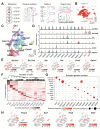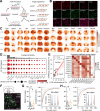This is a preprint.
Opioid-driven disruption of the septal complex reveals a role for neurotensin-expressing neurons in withdrawal
- PMID: 38293241
- PMCID: PMC10827099
- DOI: 10.1101/2024.01.15.575766
Opioid-driven disruption of the septal complex reveals a role for neurotensin-expressing neurons in withdrawal
Update in
-
Opioid-driven disruption of the septum reveals a role for neurotensin-expressing neurons in withdrawal.Neuron. 2025 Jul 23;113(14):2325-2343.e9. doi: 10.1016/j.neuron.2025.04.024. Epub 2025 May 15. Neuron. 2025. PMID: 40378834
Abstract
Because opioid withdrawal is an intensely aversive experience, persons with opioid use disorder (OUD) often relapse to avoid it. The lateral septum (LS) is a forebrain structure that is important in aversion processing, and previous studies have linked the lateral septum (LS) to substance use disorders. It is unclear, however, which precise LS cell types might contribute to the maladaptive state of withdrawal. To address this, we used single-nucleus RNA-sequencing to interrogate cell type specific gene expression changes induced by chronic morphine and withdrawal. We discovered that morphine globally disrupted the transcriptional profile of LS cell types, but Neurotensin-expressing neurons (Nts; LS-Nts neurons) were selectively activated by naloxone. Using two-photon calcium imaging and ex vivo electrophysiology, we next demonstrate that LS-Nts neurons receive enhanced glutamatergic drive in morphine-dependent mice and remain hyperactivated during opioid withdrawal. Finally, we showed that activating and silencing LS-Nts neurons during opioid withdrawal regulates pain coping behaviors and sociability. Together, these results suggest that LS-Nts neurons are a key neural substrate involved in opioid withdrawal and establish the LS as a crucial regulator of adaptive behaviors, specifically pertaining to OUD.
Figures







References
Publication types
Grants and funding
LinkOut - more resources
Full Text Sources
